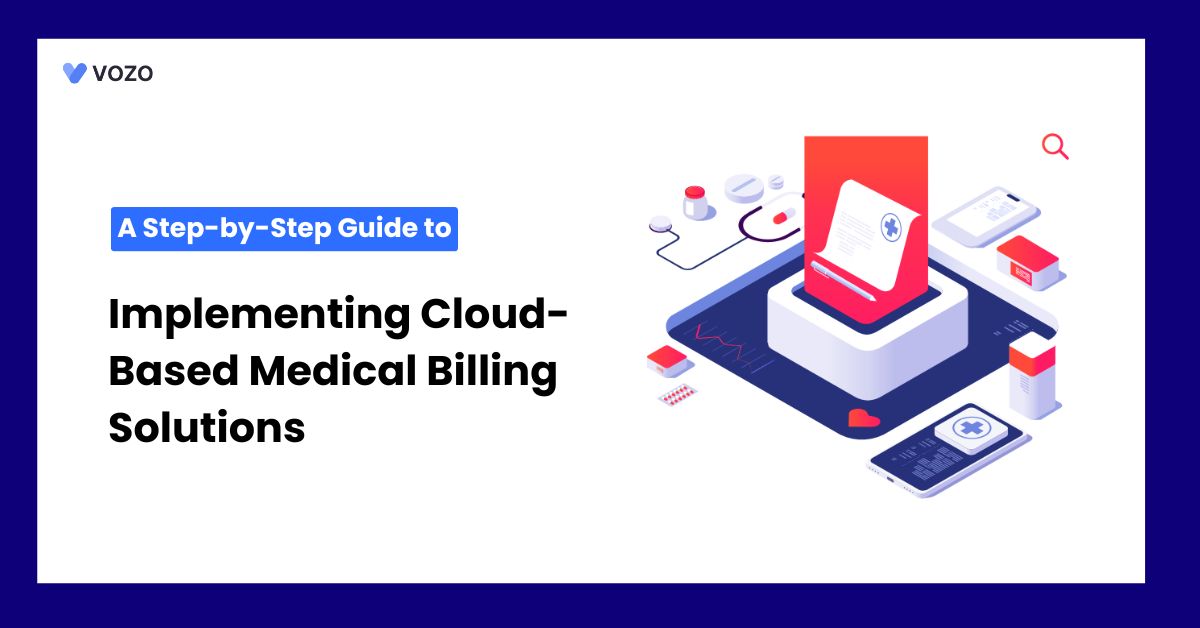A Step-by-Step Guide to Implementing Cloud-Based Medical Billing Solutions
Medical Billing is the most crucial aspect of healthcare. Because it ensures steady cash flow. A well-organized system will help to reduce medical errors and improve cash processing. However, traditional medical billing systems have many challenges.
Technology advancement in healthcare has introduced cloud-based systems. These solutions simplify the billing process significantly. They help in automating tasks and reducing errors.
Additionally, they provide secure access to financial data anytime. This guide explains cloud-based medical billing, why it is better than traditional systems, and the implementation plan’s step-by-step process.
What is a Cloud-Based Medical Billing Solution?
A cloud-based medical billing solution is software hosted on remote servers or web-based and accessed via the Internet. This software enables providers to manage billing, submit claims, and track payments. Instead of using local servers, data is stored securely online.
Key features of cloud-based medical billing software include:
- Access billing data securely from any location at any time.
- Automatically fills claims and verifies insurance details quickly.
- Uses encryption and backups for safe data storage.
- Adapts to clinics, hospitals, and multi-location healthcare setups.
- Connects with EHRs and PMS for improved workflows.
- Generates reports for better financial decision-making.
The cloud-based medical billing system makes the process easier and more efficient. It saves providers and billing staff members time and improves billing accuracy. Moreover, it ensures enhanced security and reduces operational costs.
Related: The Definitive Guide to Medical Billing
Why Shift from Traditional to Cloud-Based Billing?
If a healthcare provider uses a traditional billing system, they have to work on billing tasks manually. Manual workflow is more time-consuming and prone to errors. They are also expensive to maintain over time. There are many challenges associated with the traditional medical billing system:
- Requires hardware, IT support, and frequent software updates.
- Staff must be present physically to access billing data.
- Data entry mistakes lead to claim rejections and delays.
- Updates to regulations require manual adjustments regularly.
- Local servers are prone to loss, cyberattacks, or damage.
The cloud-based medical billing system has a comprehensive solution to tackle every challenge associated with traditional systems. Cloud-based medical billing system ensures:
- Eliminates IT maintenance and infrastructure expenses.
- Work from any location with secure login credentials.
- Automated processes minimize human mistakes in claims.
- The system updates regularly for legal adherence.
- Multiple backups prevent data loss and breaches.
This is why transitioning to a cloud-based medical billing system is important. It helps improve billing workflow efficiency, allowing providers to focus more on patient care. Cloud-based systems also ensure financial stability and compliance.
Key Benefits of Cloud-Based Medical Billing Solution for Healthcare Providers
Cloud-based medical billing software offers various benefits to healthcare organizations.
- Reduced Costs & Less IT Dependency: Cloud-based systems don’t require expensive IT support and software maintenance. They also reduce paperwork and automate manual billing processes.
- Improved Accessibility & Scalability: It allows staff to access billing data remotely anytime and can scale to fit small clinics or large healthcare organizations.
- Faster Payments & Enhanced Cash Flow: This system helps to submit claims quickly for faster payment processing. Also, it provides real-time payment tracking for better financial planning.
- Strong Security & Compliance: The system protects patient data through encryption and authentication and ensures HIPAA compliance through regular security updates.
- Advanced Reporting & Financial Insights: Provides detailed reports on claims, payments, and revenue trends. This helps providers make data-driven financial decisions.
Related: Top Medical Billing Software Features to Look out for
Step-By-Step Guide to Implementing Cloud-Based Medical Billing Solutions
Healthcare providers need a structured approach for the successful implementation of the cloud-based medical billing system. A smooth transition requires careful planning and execution.
1. Assessing Business and Technical Requirements
- Initially before implementation, you need to ensure identifying the challenges involved in the current medical billing process.
- Set a clear goal for the new system. For instance, it must reduce claim denials or improve the patient billing experience.
- Now, determine the software compatibility with other healthcare systems like EHR or PMS.
2. Choosing the Right Cloud-Based Medical Billing Solution
- After that, in-depth marketplace research will be conducted to find potential vendors. And their experience in healthcare and industry standards.
- Compare the software features like automation, claims management, denial management, reporting, and patient portals.
- Consider checking for customer support availability and their response time.
3. Implementation Planning
- After choosing the vendor, consider developing a structured timeline with specific milestones for the implementation.
- Assign a dedicated team of key stakeholders for perfect execution.
- Identify challenges beforehand and then develop a plan to address them.
4. Integration with Existing Systems
- Once the implementation is done, the next plan is for the secure transfer of medical billing data to the newer system.
- Ensure that the new cloud-based medical billing system integrates with EHR and other software.
- Conduct deep testing to ensure that all systems communicate well and workflows remain uninterrupted.
5. Testing and Deployment
- Instead of a complete deployment, run pilot testing to identify and resolve issues.
- Consider conducting training sessions for providers, and billing staff on system usage and troubleshooting.
- Offer immediate support during the initial launch to address any issues that arise.
6. Post-Implementation and Optimization
- Regularly review system performance and user feedback to identify areas for improvement.
- Keep staff updated on new features and best practices to maximize the system’s benefits.
- Track key indicators such as claim approval rates and billing cycle times to measure success.
Related: Enhance Medical Billing: 5 Tips to Transform Patient Financial Experience
Vozo Cloud EHR Integrated with Medical Billing
Medical billing is a complex healthcare operation that requires efficiency and precision. Delayed payments, claim denials, and manual errors can slow your revenue cycle and affect cash flow.
With Vozo’s Cloud EHR solution, you get an integrated medical billing system that simplifies your billing process and enhances real-time claim tracking to improve payment turnaround.
How Vozo EHR Transforms Medical Billing:
- Streamline billing workflows and reduce administrative workload.
- Instantly identifies and corrects coding errors before claim submission.
- Speeds up claim verification with automated payer communication.
- Ensures compliance with built-in coding checks and regulatory updates.
- Offers real-time analytics and reporting for better decision-making.
- Minimizes delays by automating claims processing and payments.
- Reduces billing disputes with accurate, transparent invoicing.
Vozo EHR’s seamless integration with medical billing empowers healthcare providers to reduce errors, prevent delays, and optimize revenue cycles, all while focusing on delivering better patient care.
About the author

With more than 4 years of experience in the dynamic healthcare technology landscape, Sid specializes in crafting compelling content on topics including EHR/EMR, patient portals, healthcare automation, remote patient monitoring, and health information exchange. His expertise lies in translating cutting-edge innovations and intricate topics into engaging narratives that resonate with diverse audiences.













